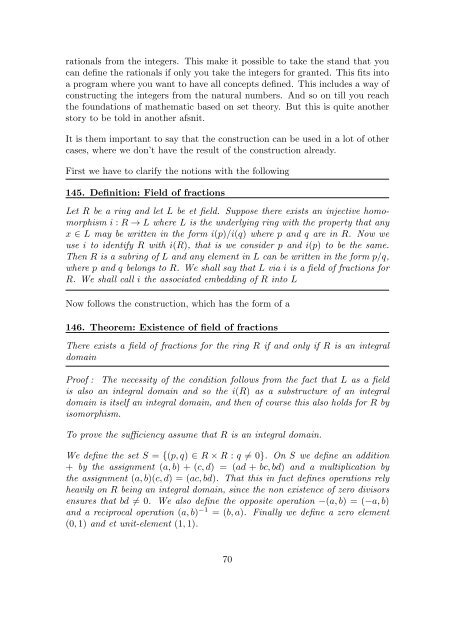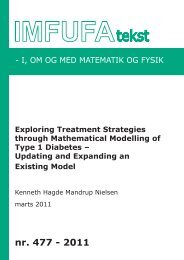ABSTRACT ALGEBRAIC STRUCTURES OPERATIONS AND ...
ABSTRACT ALGEBRAIC STRUCTURES OPERATIONS AND ...
ABSTRACT ALGEBRAIC STRUCTURES OPERATIONS AND ...
Create successful ePaper yourself
Turn your PDF publications into a flip-book with our unique Google optimized e-Paper software.
ationals from the integers. This make it possible to take the stand that you<br />
can define the rationals if only you take the integers for granted. This fits into<br />
a program where you want to have all concepts defined. This includes a way of<br />
constructing the integers from the natural numbers. And so on till you reach<br />
the foundations of mathematic based on set theory. But this is quite another<br />
story to be told in another afsnit.<br />
It is them important to say that the construction can be used in a lot of other<br />
cases, where we don’t have the result of the construction already.<br />
First we have to clarify the notions with the following<br />
145. Definition: Field of fractions<br />
Let R be a ring and let L be et field. Suppose there exists an injective homomorphism<br />
i : R → L where L is the underlying ring with the property that any<br />
x ∈ L may be written in the form i(p)/i(q) where p and q are in R. Now we<br />
use i to identify R with i(R), that is we consider p and i(p) to be the same.<br />
Then R is a subring of L and any element in L can be written in the form p/q,<br />
where p and q belongs to R. We shall say that L via i is a field of fractions for<br />
R. We shall call i the associated embedding of R into L<br />
Now follows the construction, which has the form of a<br />
146. Theorem: Existence of field of fractions<br />
There exists a field of fractions for the ring R if and only if R is an integral<br />
domain<br />
Proof : The necessity of the condition follows from the fact that L as a field<br />
is also an integral domain and so the i(R) as a substructure of an integral<br />
domain is itself an integral domain, and then of course this also holds for R by<br />
isomorphism.<br />
To prove the sufficiency assume that R is an integral domain.<br />
We define the set S = {(p, q) ∈ R × R : q ̸= 0}. On S we define an addition<br />
+ by the assignment (a, b) + (c, d) = (ad + bc, bd) and a multiplication by<br />
the assignment (a, b)(c, d) = (ac, bd). That this in fact defines operations rely<br />
heavily on R being an integral domain, since the non existence of zero divisors<br />
ensures that bd ̸= 0. We also define the opposite operation −(a, b) = (−a, b)<br />
and a reciprocal operation (a, b) −1 = (b, a). Finally we define a zero element<br />
(0, 1) and et unit-element (1, 1).<br />
70
















